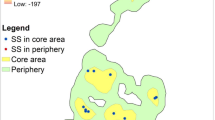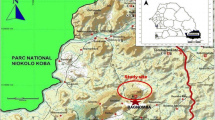Abstract
We conducted ecological studies of chimpanzees (Pan troglodytes) in the Ugalla area, western Tanzania. Ugalla is one of the driest habitats of chimpanzees and the Ugalla River is the eastern boundary of chimpanzee distribution. Most of Ugalla is occupied by savanna woodlands dominated by deciduous trees of Brachystegia and Julbernardia. Chimpanzees tended not to make nests in riverine forests in plains, but in small patchy forests dominated by Monopetalanthus richardsiae and valley forests dominated by Julbernardia unijugata on slopes in mountainous areas. We estimated population density of chimpanzees to be 7–9 × 10−2 individuals/km2 based on nest censuses, suggesting that 2–3 × 102 individuals inhabited the 3352 km2 area of Ugalla. The size of the largest nest cluster (n=23) suggests that 1 unit group (community) comprised 30–35 individuals. In the daytime, chimpanzees formed small feeding parties (mean 2.0 individuals), but larger ones in the evening (mean 4.8 individuals and 5.2 individuals based on fresh nest clusters). The pattern might reduce the predation risk from large nocturnal carnivores such as lions and leopards. The sleeping sites may function as both a safe sleeping site and a meeting point for chimpanzees with a huge home range that may have difficulty in finding other members of their unit group.


Similar content being viewed by others
References
Baldwin, P. J., McGrew, W. C., & Tutin, C. E. G. (1982). Wild-ranging chimpanzees at Mt. Assirik, Senegal. International Journal of Primatology, 3, 367–385.
Baldwin, P. J., Sabaster, P. J., McGrew, W. C., & Tutin, C. E. G. (1981). Comparison of nests made by different populations of chimpanzees. Primates, 22, 474–486.
Boesch, C. (1991). The effects of leopard predation pattern in grouping patterns in forest chimpanzees. Behaviour, 117, 220–241.
Boesch, C., & Boesch, H. (1989). Hunting behavior of wild chimpanzees in the Tai National Park. American Journal of Primatology, 78, 547–573.
Carrol, R. W. (1986). Status of the lowland gorilla and other wildlife in the Dzanga-Sangha region of southweatern Central African Republic. Primate Conservation, 7, 38–41.
Goodall, J. (1968). The behavior of free-living chimpanzees in the Gombe stream area. Animal Behaviour Monographs, 1, 16–311.
Goodall, J. (1986). The chimpanzees in Gombe: Patterns of behavior. Cambridge: Harvard University Press.
Ghiglieri, M. P. (1984). The chimpanzees of Kibale forest: A field study of ecology and social structure. New York: Columbia University Press.
Hashimoto, C. (1995). Population census of the chimpanzees in the Kalinzu forest,Uganda: Comparison between methods with nest census. Primates, 36, 477–488.
Hoppe-Dominik, B. (1991). Distribution and status of chimpanzees (Pan troglodytes) on the Ivory Coast. Primate Report, 31, 45–47.
Ihobe, H. (2005). Life span of chimpanzee beds at the Mahale Mountains National Park, Tanzania. Pan Africa News, 12, 10–12.
Itani, J. (1979). Distribution and adaptation of chimpanzees in an arid area. In D. A. Hamburg & E. R. McCown (Eds.), The great apes (pp. 55–71). Menlo Park, CA: Benjamin/Cummings.
Itani, J., & Suzuki, A. (1967). The social unit of chimpanzees. Primates, 8, 355–381.
Izawa, K. (1970). Unit groups of chimpanzees and their nomadism in the savanna woodland. Primates, 2, 1–46.
Jones, C., & Sabater, P. J. (1971). Comparative ecology of Gorilla gorilla (Savage and Wyman) and Pan troglodytes (Blumenbach) in Rio Muni, Weat Africa. Bibliotheca Primatologica, 13, 1–96.
Kano, T. (1971). Distribution of primates on the eastern shore of Lake Tanganyika. Primates, 12, 281–304.
Kano, T. (1972). Distribution and adaptation of the chimpanzee on the eastern shore of Lake Tanganyika. Kyoto University African Studies, 7, 37–129.
Kano, T., & Asato, R. (1994). Hunting pressure on chimpanzees and gorillas in the Motaba river are, northeastern Congo. African Study Monographs, 15, 143–162.
Kikula, I. S. (1986). Environmental effects of Tanzania’s villagisation program. Ph.D. thesis, Griffith University, Brisbane.
Kortlandt, A. (1983). Marginal habitats of chimpanzees. Journal of Human Evolution, 12, 231–278.
Massawe, E. T. (1992). Assessment of the status of chimpanzee populations in western Tanzania. African Study Monographs, 13, 35–55.
McGrew, W. C., Baldwin, P. J., & Tutin, C. E. G. (1981). Chimpanzees in a hot, dry and open habitat: Mt. Assirik, Senegal, west Africa. Journal of Human Evolution, 10, 227–244.
Mitani, M. (1992). Preliminary results of the studies on wild western lowland gorillas and other sympatric diurnal primates in the Ndoki Forest, northern Congo. In N. Itoigawa, Y. Sugiyama, C. P. Sackett, R. K. R. Thompson (Eds.), Topics in primatology, vol. 2: Behavior, ecology, and conservation (pp. 99–118). Tokyo: University of Tohyo Press.
Moore, J. (1992). “Savanna” chimpanzees. In T. Nishida, W. C. McGrew, P. Marler, M. Pickford, & F. B. M. de Waal (Eds.), Topics in primatology, vol. 1: Human origins (pp. 99–118). Tokyo: University of Tokyo Press.
Moore, J. (1994). Plants of the Tongwe east reserve (Ugalla), Tanzania. Tropics, 3, 333–340.
Moore, J. (1996). Savanna chimpanzees, referential models and the last common ancestor. In W. C. McGrew, L. Marchant, & T. Nishida (Eds.), Great ape societies (pp. 275–292). Cambridge: Cambridge University Press.
Nishida, T. (1968). The social group of wild chimpanzees in the Mahale Mountains. Primates, 9, 167–224.
Nishida, T. (1989). A note on chimpanzee ecology of the Ugalla area, Tanzania. Primates, 30, 129–138.
Nishida, T. (1990). A quarter century of research in the Mahale Mountains. In T. Nishida (Ed.), The chimpanzees of the Mahale mountains: Sexual and life history strategies (pp. 3–35). Tokyo: University of Tokyo Press.
Nishida, T., Takasaki, H., & Takahata, Y. (1990). Demography and reproductive profiles. In T. Nishida (Ed.), The chimpanzees of the Mahale mountains: Sexual and life history strategies (pp. 63–97). Tokyo: University of Tokyo Press.
Nishida, T., & Uehara, S. (1981). Kitongwe name of plants: A preliminary listing. African Study Monographs, 1, 109–131.
Ogawa, H. (1995). Feeding and sleeping parties of Tschego Chimpanzees (Pan troglodytes troglodytes) in the Nouabale-Ndoki national park. Rapport Annuel 1994–1995 pour Recherches Scientifiques Cooperatives par Equipes Japonaises et Congolaises, pp. 54–58.
Ogawa, H., Kanamori, M., & Mukeni, S. H. (1997). The Discovery of chimpanzees in the Loasi River area, Tanzania: A new southern distribution Limit. Pan Africa News, 4, 1–3.
Plumptre, A. J., & Cox, D. (2006). Counting primates for conservation: Primate surveys in Uganda. Primates, 47, 65–73.
Plumptre, A. J., & Reynolds, V. (1997). Nesting behavior of chimpanzees: Implications for censuses. International Journal of Primatology, 18, 475–485.
Reynolds, V., & Reynolds, F. (1965). Chimpanzees in the Budongo Forest. In I. deVore (Ed.), Primate behavior: Field studies of monkeys and apes (pp. 468–524). San Francisco: Holt, Rinehart and Winston.
Schoeninger, M., Moore, J., & Sept, J. (1999). Subsistence strategies of two “savanna” chimpanzee populations: The stable isotope evidence. American Journal of Primatology, 49, 297–314.
Sutton, J. E. G., & Roberts, A. D. (1968). Uvinza and its salt industry. Azania, 3, 45–869.
Suzuki, A. (1969). An ecological study of chimpanzees in a savanna woodland. Primates, 10, 103–148.
Teleki, G. (1977). The predatory behavior of wild chimpanzees. Lewisburg, PA: Bucknell University Press.
Teleki, G. (1989). Population status of wild chimpanzees (Pan troglodytes) and threats to survival. In G. H. Paul & A. M. Linda (Eds.), Understanding chimpanzees (pp. 312–353). Cambridge, MA: Harvard University Press.
Tutin, C., & Fernandez, M. (1984). Nationwide census of gorilla (Gorilla g. Gorilla) and chimpanzee (Pan t. troglodytes) population in Gabon. American Journal of Primatology, 6, 313–336.
Tutin, C. E. G., McGrew, W. C., & Baldwin, P. J. (1983). Social organization of savanna-dwelling chimpanzees, Pan troglodytes verus, at Mt. Assirik, Senegal. Primates, 24, 154–173.
Wrangham, R. W. (1979). On the evolution of ape social systems. Social Science Information, 18, 335–368.
Acknowledgments
We thank Takayoshi Kano, Masaomi Kanaomi, Hosea Y. Kayumbo, Edeus T. Massawe, Junichiro Itani, Toshisada Nishida, Are Thune Paulsen, Toshimichi Nemoto, Alexander Piel, Fiona Stewart, and Kirit Vaitha for their suggestions and cooperation of the survey; Emanweli K. Sehele, Batromeo Kadyugenze, Arfani Murorerowa, Moshi Rajabu, Ramadhani Bilali, Busoti Juma, Abdall Saidi, and other local assistants for their help; Frank Mbago, Yahya Abeid, and other members of Herbarium, Dar es Salaam University, and Kaji Vollesen for plant identification; Daiji Kimura and offices of Meteorology for the data on vegetation and weather. The data and primary responsibility for this article are those of H. Ogawa and G. Idani, with J. Moore, A. Hernandez-Aguilar, and L. Pintea contributing unpublished data, discussion, and assistance with writing during H. Ogawa’s sabbatical at University of California, San Diego. The Tanzanian authorities (Costech and Tawiri) granted permission for the study. A Grand-in-Aid for Scientific Research of MEXT, Japan (06061064; 09041160; 1257597; 17255005) and Global Environment Research Fund F061 provided funding for H. Ogawa and G. Idani. The Leakey Foundation and UCSD Committer on Research provided funding for J. Moore, and the NSF and Leakey Foundation provided funding for A. Hernandez-Aguilar.
Author information
Authors and Affiliations
Corresponding author
Rights and permissions
About this article
Cite this article
Ogawa, H., Idani, G., Moore, J. et al. Sleeping Parties and Nest Distribution of Chimpanzees in the Savanna Woodland, Ugalla, Tanzania. Int J Primatol 28, 1397–1412 (2007). https://doi.org/10.1007/s10764-007-9210-0
Received:
Revised:
Accepted:
Published:
Issue Date:
DOI: https://doi.org/10.1007/s10764-007-9210-0




